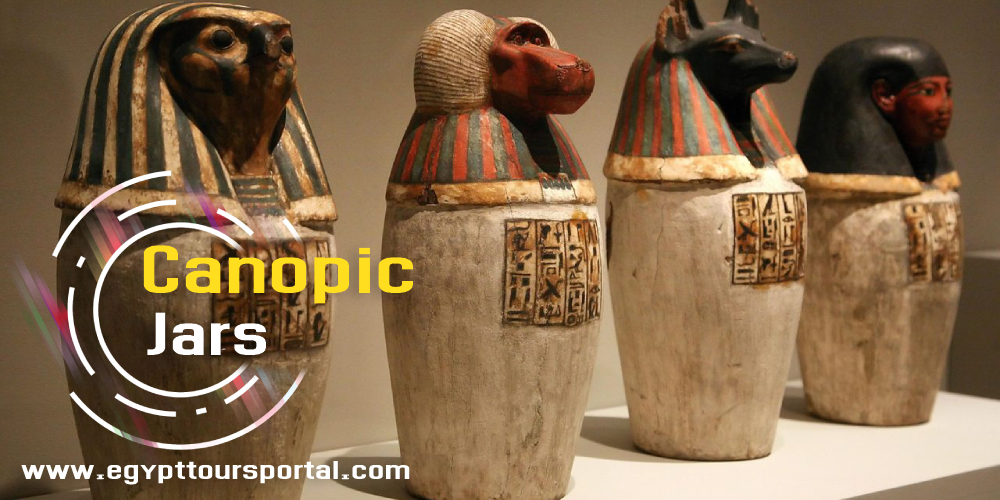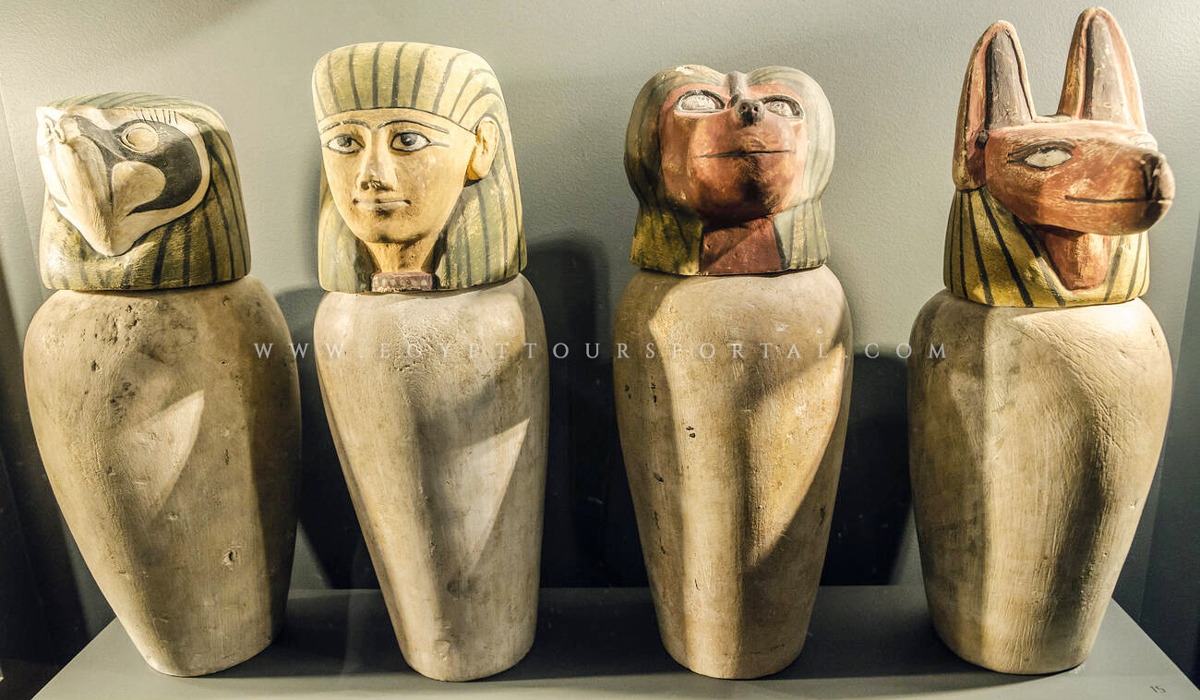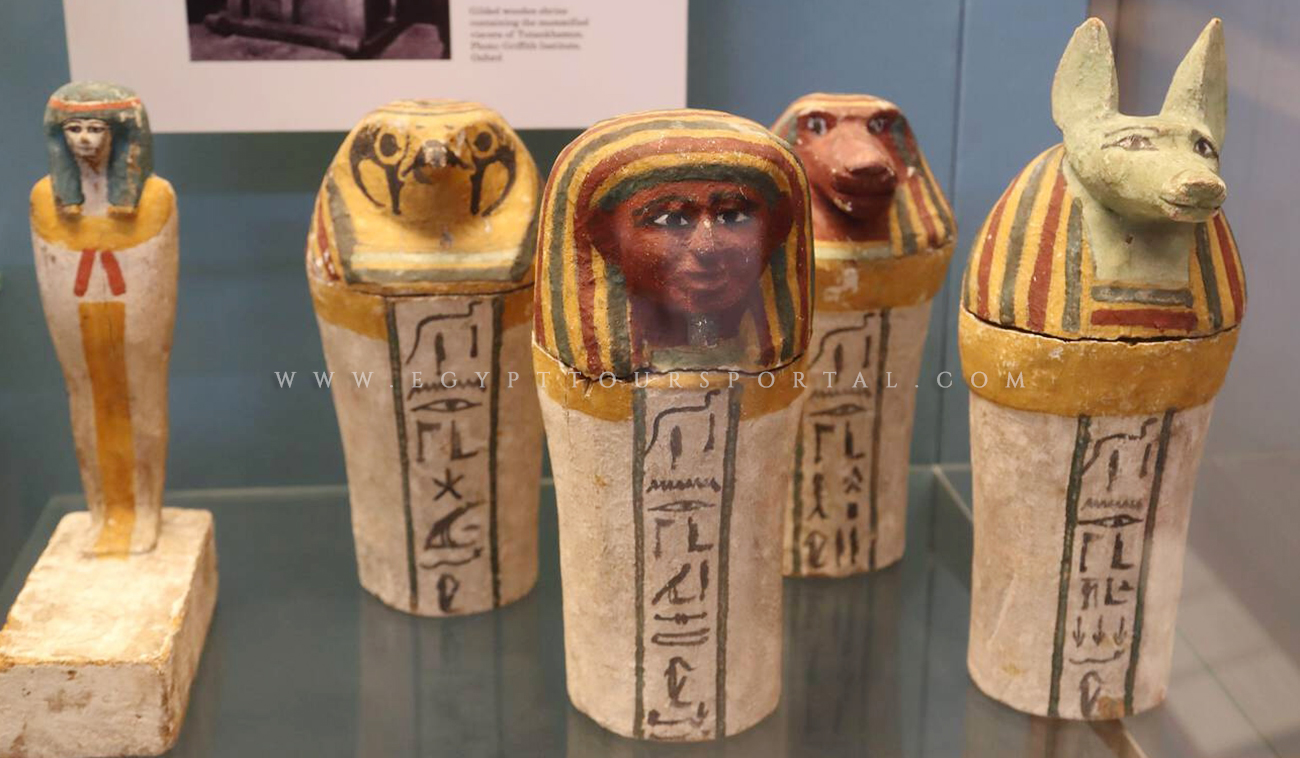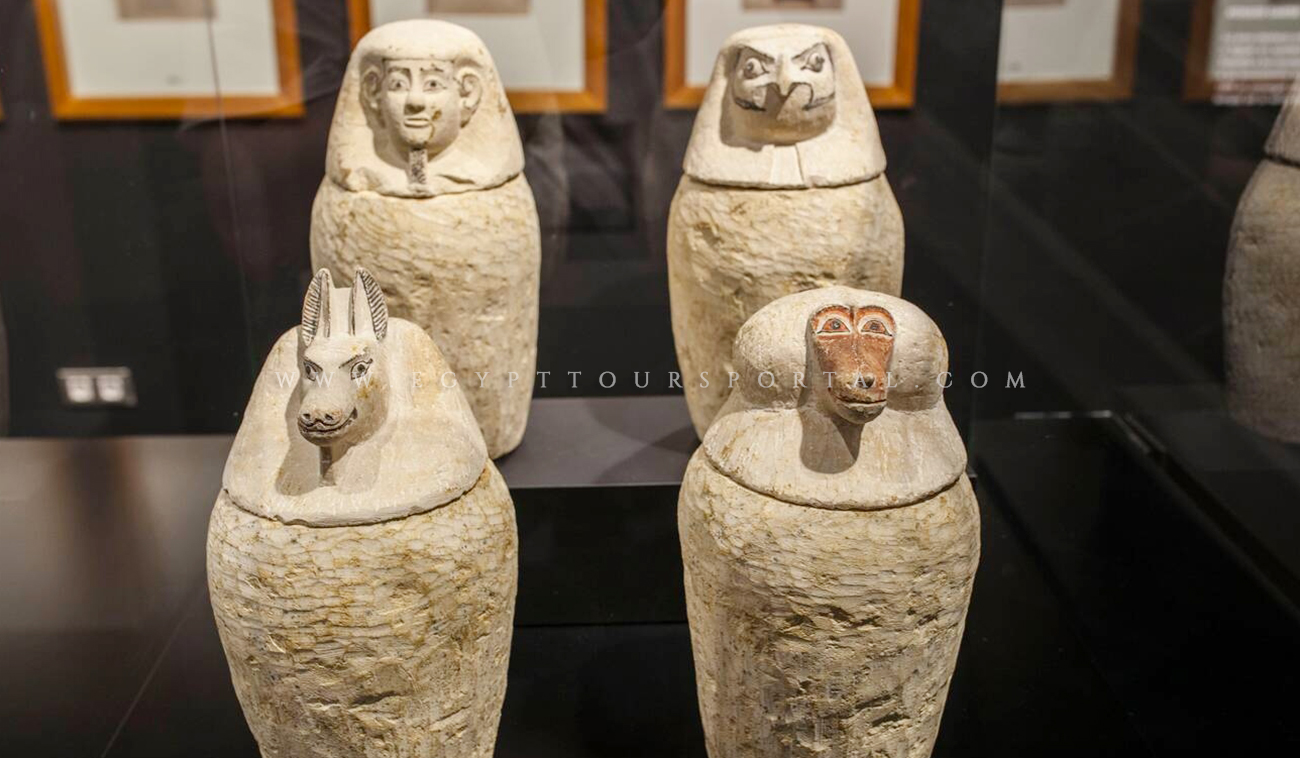Explore the fascinating history and significance of ancient Egyptian Canopic jars, used for preserving organs during mummification. Discover their evolution, design, and cultural importance in the journey to the afterlife.

The Canopic jars were used by ancient Egyptians during the mummification process to hold the internal organs that were removed from the deceased. They were carved from limestone or made from pottery and were commonly used in Egypt's old kingdom until the Ptolemaic period. They were stone vessels with flat lids, and human-headed masks were added later in the old kingdom.
In the late 18th dynasty, the stoppers of the jars were shaped with the heads of four minor funerary deities known as the "Four Sons of Horus" who were also considered the cardinal compass points; they are the baboon-headed Happy, the human-headed Imsety, the jackal-headed Duamutef, and the falcon-headed Qebehsenuef.

The Canopic jars were four and were used to hold organs like the stomach, intestines, lungs, and liver after being removed from the body, embalmed, anointed, and wrapped in linen. As for the heart, well, the ancient Egyptians chose to leave it in its place as they believed that the heart held the soul. The ancient Egyptians believed that life was immortal and death was nothing more but a door to the other side. Each one of the sons of hours was responsible for a direction and an organ; they are:
The jars were placed inside a canopic chest and buried in the tombs with the sarcophagus of the dead. Many sets of jars survive from the old kingdom, in alabaster, aragonite, calcareous stone, and blue or green glazed porcelain, carrying inscriptions on the outside and can be viewed in Egyptian museums or any museum around the world.

Ancient Egyptians utilized these vessels, known as canopic jars, at the dawn of the Old Kingdom (2700 - 2200 BC) through the Late Period (664 - 330 BC) and the Ptolemaic Period (305 - 30 BC). During this time, the practice evolved from storing the viscera within these jars to simply wrapping and placing them alongside the body. Contrary to early assumptions linking the term "Canopic" to the Greek legend of Canopus, various theories suggest its origin stems from either Canopus in the Delta or the location near Alexandria, where human-headed jars symbolizing the god Osiris were revered. The evolution of the Canopic jar can be traced back to the 4th dynasty. The earliest known examples of these jars belonged to Queen Hetepheres, wife of King Sneferu and mother of King Cheops. The first Canopic jars discovered belonged to Queen Meresankh III, the wife of King Khafre.
Explore 50 famous Ancient Egyptian coffins with informative facts and captivating photos of each ancient Egyptian coffin in this article. Click now!
Read MoreThroughout the different time periods, the design and purpose of canopic jars evolved from the Old Kingdom as they were often uninscribed with plain lids, while in the Middle Kingdom of ancient Egypt (2040 - 1782 BC), inscriptions became more common, and lids frequently took the form of human heads. By the Nineteenth Dynasty of the New Kingdom of ancient Egypt (1570 - 1050 BC), the lids depicted the four sons of Horus serving as guardians of the organs. Materials and styles varied over time, with the oldest jars dating back to the Eleventh or Twelfth Dynasty, typically crafted from stone or wood. By the New Kingdom, canopic jars featured the sons of Horus, often made from alabaster, aragonite, calcareous stone, or glazed porcelain. These sons of Horus, representing cardinal compass points, each safeguarded specific organs and were accompanied by a companion goddess. During the Third Intermediate Period, dummy canopic jars were introduced alongside advancements in embalming techniques, allowing the viscera to remain within the body. Although traditional canopic jars remained a prominent feature in tombs, they were no longer used for organ storage. Numerous canopic jars have survived throughout history and can be found in museums worldwide, showcasing the enduring legacy of ancient Egyptian burial practices.

Canopic jars are beautiful symbols that represent the true meaning of the ancient Egyptian faith. Egypt is full of amazing artifacts like these, which are spread all over the country in Cairo, Luxor, and Aswan. Don't miss the chance to witness them all and discover ancient Egyptian civilization with our private Egypt tours.
Private 4 Days Cairo Tour Packages 4 days Cairo Egypt tour package will offer a bles...
Tour Location: Cairo – Giza...
Stunning 5 Days Cairo and Alexandria Tour Package 5 days Cairo and Alexandria tour p...
Tour Location: Cairo/Giza/Alexandria...
Exceptional 6 Days Cairo, Luxor & Aswan Tour Package 6 days Cairo, Luxor & A...
Tour Location: Cairo/Giza/Aswan/Luxor...
Amazing 7 Days Cairo and Hurghada Holiday 7 Days Cairo & Hurghada holiday will e...
Tour Location: Cairo – Giza – Hurgh...
There are a lot of misconceptions and false information when it comes to canopic Jars. For example, The Egyptians believed the heart was the seat of the soul and left it inside the body during mummification, which means the heart was not placed in a canopic Jar, but the other organs, which are the lungs, liver, intestines, and stomach. Also, canopic jars used to contain internal organs had no connection with Canopus. Ancient Greeks were used to holding objects of wealth for the Greek upper class, which is also not correct.
Canopic jars were typically made of various materials such as limestone, alabaster, pottery, Faience, and calcite.
These jars were used by ancient Egyptians from the Old Kingdom (2575– 2130 BCE) until the Late Period or the Ptolemaic Period (332–30 BCE).
Making clay canopic jars has a number of steps, which include wedging the clay to remove air bubbles in order to achieve consistency, then throwing the clay on a potter's wheel or hand-building the desired shape. Smoothing and refining the surface follows, which also includes adding details like lids. The final step is drying the jar slowly to prevent cracking and then firing it in a kiln at high temperatures for permanent hardening. Decoration is an optional but recommended option that includes painting or adding decorative elements after firing.
Canopic jars represent the four sons of Horus, who were the protectors of the deceased's internal organs in ancient Egyptian belief. Each jar was associated with a specific organ and guardian deity of the Four Sons of Horus who were found decorating the heads of jars. Egyptians believed these organs found in the canopic jars were necessary for the journey of the deceased in the afterlife.
Ancient Egyptians knew that canopic jars stored organs because they were often inscribed or decorated with the heads of the four sons of Horus, each associated with a specific organ. The lids of the jars were typically shaped like the heads of these deities.
The organs were treated with natron salt to remove moisture and prevent decay. Any remaining fluid would likely have been a residue remaining from the mixture of bodily fluids and embalming materials.
The entire country of Egypt deserve to be explored with its every heavenly detail but there are places that must be seen before any other such as the breathtaking Hurghada's red sea, The wonders of Cairo the pyramids of Giza, the great sphinx, the Egyptian Museum, Khan El Khalili Bazaar, the wonders of Luxor like Valley of the Kings, Karnak & Hatshepsut temple and the wonders of Aswan such as Abu Simbel temples, Philea temple, Unfinished obelisk and The Wonders of Alexandria like Qaitbat Citadel, Pompey's Pillar and Alexandria Library. Read more about the best places to visit in Egypt.
If you want to apply for a Visa On Arrival that lasts for 30 days then you should be one of the eligible countries, have a valid passport with at least 6 months remaining and pay 25$ USD in cash, as for the E-Visa for 30 day you should have a valid passport for at least 8 months, complete the online application, pay the e-visa fee then print the e-visa to later be presented to the airport border guard. You could also be one of the lucky ones who can obtain a free visa for 90 days. Read more about Egypt travel visa.
Egypt has a variety of delicious cuisines but we recommend “Ful & Ta’meya (Fava Beans and Falafel)”, Mulukhiya, “Koshary”, a traditional Egyptian pasta dish, and Kebab & Kofta, the Egyptian traditional meat dish.
The best time to travel to Egypt is during the winter from September to April as the climate becomes a little tropical accompanied by a magical atmosphere of warm weather with a winter breeze. You will be notified in the week of your trip if the Climate is unsafe and if any changes have been made.
You should pack everything you could ever need in a small bag so you could move easily between your destinations.
We have been creating the finest vacations for more than 20 years around the most majestic destinations in Egypt. Our staff consists of the best operators, guides and drivers who dedicate all of their time & effort to make you have the perfect vacation. All of our tours are customized by Travel, Financial & Time consultants to fit your every possible need during your vacation. It doesn't go without saying that your safety and comfort are our main priority and all of our resources will be directed to provide the finest atmosphere until you return home.
You will feel safe in Egypt as the current atmosphere of the country is quite peaceful after the government took powerful measures like restructuring the entire tourist police to include all the important and tourist attractions in Egypt. Read more about is it safe to travel to Egypt.
Wear whatever feels right and comfortable. It is advised to wear something light and comfortable footwear like a closed-toe shoe to sustain the terrain of Egypt. Put on sun block during your time in Egypt in the summer to protect yourself from the sun.
The best activity is by far boarding a Nile Cruise between Luxor and Aswan or Vise Versa. Witness the beauty of Egypt from a hot balloon or a plane and try all the delicious Egyptian cuisines and drinks plus shopping in old Cairo. Explore the allure and wonders of the red sea in the magical city resorts of Egypt like Hurghada and many more by diving and snorkeling in the marine life or Hurghada. Behold the mesmerizing western desert by a safari trip under the heavenly Egyptian skies.
There are a lot of public holidays in Egypt too many to count either religious or nation, the most important festivals are the holy month of Ramadan which ends with Eid Al Fitr, Christmas and new years eve. Read more about festivals & publich holidays in Egypt.
Egypt is considered to be one of the most liberal Islamic countries but it has become a little bit conservative in the last couple of decades so it is advised to avoid showing your chest, shoulders or legs below the knees.
Arabic is the official language and Most Egyptians, who live in the cities, speak or understand English or at least some English words or phrases. Fewer Egyptians can speak French, Italian, Spanish, and German. Professional tour guides, who work in the tourism sector, are equipped to handle visitors who cannot speak Arabic and they will speak enough English and other languages to fulfill the needs of all our clients.
The fastest way is a car, of course, a taxi. If you are in Cairo ride a white taxi to move faster or you could board the fastest way of transportation in Egypt metro if the roads are in rush hour.
The temperature in Egypt ranges from 37c to 14 c. Summer in Egypt is somehow hot but sometimes it becomes cold at night and winter is cool and mild. The average of low temperatures vary from 9.5 °C in the wintertime to 23 °C in the summertime and the average high temperatures vary from 17 °C in the wintertime to 32 °C in the summertime. The temperature is moderate all along the coasts.
It is the home of everything a traveler might be looking for from amazing historical sites dating to more than 4000 years to enchanting city resorts & beaches. You will live the vacation you deserve as Egypt has everything you could possibly imagine.









